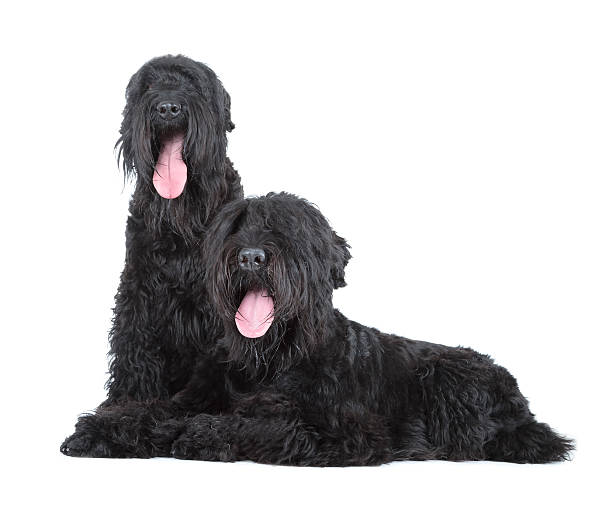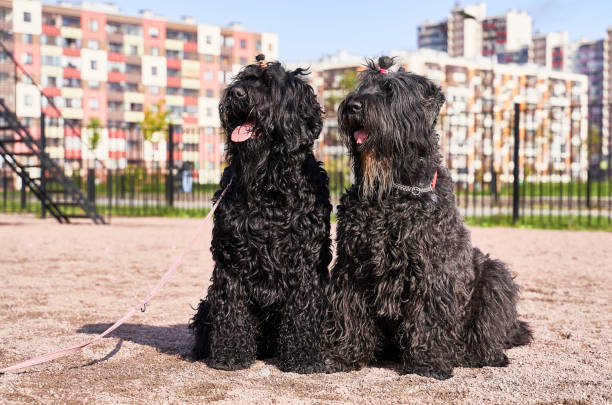Black Russian Terrier

Breed History:
The Black Russian Terrier (BRT) was developed in the Soviet Union during the 1940s and 1950s as a military and guard dog. The Soviet Red Star Kennel created the breed by crossing over 17 different breeds, including the Giant Schnauzer, Rottweiler, Airedale Terrier, Newfoundland, and Caucasian Shepherd Dog, aiming to create a strong, intelligent, and cold-tolerant working dog.
Initially used by the military and police for protection and patrol work, the BRT earned a reputation as a dependable service dog with both guarding instincts and trainability. While it was once exclusively a working dog, its loyalty and composure have made it increasingly popular as a companion in recent decades. The breed was officially recognised by the FCI in 1984 and by the AKC in 2004.
|
Gender |
Height |
Weight |
|
Male |
72-76 cm |
50-60 kg |
|
Female |
68-72 cm |
45-50 kg |
Size – Large to Giant
Life Expectancy: 10–12 years

Breed Appearance:
The Black Russian Terrier is a large, powerful, and imposing dog, covered in a dense, tousled black coat that gives it a rugged, bear-like appearance. Its head is large and blocky, with a distinctive beard and eyebrows that enhance its expressive face.
The BRT’s body is robust and well-muscled, with a straight back, deep chest, and thick, slightly curved tail. Its eyes are dark and oval, giving a calm and focused look. The breed’s gait is confident and deliberate, reflecting both strength and control.
Breed Type – Guardian/Working:
Bred specifically as a military and police working dog, the Black Russian Terrier is a natural guardian and protector. It is calm, confident, and devoted, forming strong bonds with its family and maintaining an alert watch over its home.
Despite its formidable appearance, the BRT is not aggressive without cause. With proper training and socialisation, it is gentle and affectionate with family members, including children and other pets. It needs a strong, experienced owner who can provide leadership and structure.

Training:
The Black Russian Terrier is highly intelligent, focused, and trainable, but it requires firm, consistent guidance. It excels in obedience, protection work, and various dog sports but is not ideal for novice owners due to its strength and independence.
Training should begin early, focusing on socialisation, impulse control, and structured routines. Use positive reinforcement, but maintain clear boundaries, as the BRT may become dominant or overprotective if leadership is lacking. A mentally stimulated BRT is a well-behaved BRT.
Health & Care:
The BRT is generally a healthy and resilient breed, though like many large dogs, it may face:
-
Hip and elbow dysplasia
-
Progressive retinal atrophy (PRA)
-
Allergies and skin issues
-
Heart conditions (e.g., cardiomyopathy)
-
Gastric torsion (bloat)
Regular vet check-ups, hip and eye screening, and a balanced, joint-supportive diet are essential. Puppies should avoid excessive jumping or stair climbing during growth to prevent orthopaedic issues.

Living Conditions:
The Black Russian Terrier can adapt to various homes, but it thrives in spacious environments with a securely fenced yard. It is not ideal for apartment living unless given plenty of outdoor time and structured exercise.
BRTs are deeply bonded to their people and may become anxious or restless if left alone for long periods. They do best in homes with experienced dog owners who can provide daily engagement, structure, and purpose. The breed handles cold climates well but may overheat in warm weather due to its thick coat.
Exercise:
The BRT requires at least 1 to 2 hours of daily exercise, including structured walks, training sessions, and interactive play. Without enough stimulation, it may develop undesirable behaviours like barking, pacing, or chewing.
It excels in obedience, agility, tracking, and protection sports, and benefits from advanced tasks that challenge its sharp mind. Early activity should be moderated to protect growing joints, but as an adult, the BRT is both a powerful athlete and a focused worker.
Grooming:
The Black Russian Terrier’s dense, wavy, non-shedding coat requires regular grooming to prevent matting. Brushing 2–3 times a week, plus professional trimming every 6–8 weeks, is recommended to maintain its coat and signature facial furnishings.
Bathing is occasional but necessary if the dog gets dirty. Routine ear cleaning, dental care, and nail trimming are also part of good hygiene. Owners should check for debris, especially around the beard and legs.

Advantages:
-
Exceptionally loyal and protective of family
-
Intelligent and capable of advanced training
-
Calm indoors, yet powerful and athletic
-
Low-shedding, hypoallergenic-like coat
-
Excellent working dog for protection and service roles
-
Handles cold climates very well
Disadvantages:
-
Requires extensive training and strong leadership
-
Not ideal for first-time dog owners
-
Grooming needs are intensive and ongoing
-
Can become overprotective without early socialisation
-
Needs plenty of space and regular exercise
-
May suffer from separation anxiety if left alone too long

